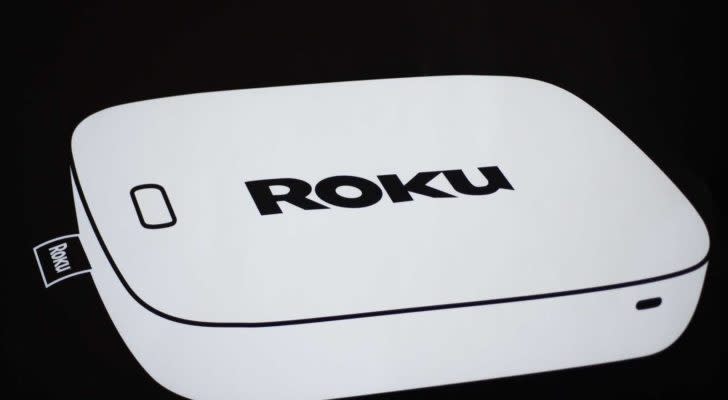Who Will Win the Streaming Wars? Netflix, Disney or Roku Stock
If I told you at the beginning of 2019 that two of your stocks would deliver 11% and 25% total returns through the first seven-and-a-half months of the year, you’d have gladly taken that performance. Well, that’s precisely where Netflix (NASDAQ:NFLX) and Disney (NYSE:DIS) today, a little more than halfway through August. Unfortunately, for owners of Netflix stock and Disney stock, Roku (NASDAQ:ROKU) stock is up 338% year to date through August 12, leaving both entertainment stocks in the dust.

Source: jejim / Shutterstock.com
Clearly, Roku is the best entertainment stock in 2019.
What happens to Netflix stock in 2020? Disney has a formidable video-streaming bundle out in November that could take market share from Reed Hastings & Co. Meanwhile, Roku doesn’t care what you watch as long as you do so through the Roku platform or on one its player devices.
InvestorPlace - Stock Market News, Stock Advice & Trading Tips
Seems like the answer to the question which of Netflix, Disney and Roku stock are good, better, and best, has already been answered by investors.
Here are my two cents on the subject.
Netflix Stock
NFLX didn’t have a great July, down 12.1% while the S&P 500 eked out a 1.3% return on the month. By comparison, Disney was up 3.0% and Roku gained a whopping 14.1%, significantly better than either of the entertainment veterans.
Netflix had some good news and bad news to deliver in July.
On the plus side, its revenues and operating income grew by 26% and 53% respectively during the second quarter, precisely what management was expecting. The bad news was that Netflix planned to add 5 million new subscribers during the quarter ended June 30. Instead, it added just 2.70 million, well below its guidance and half the 5.45 million net subscribers it added in Q2 2018.
Despite Netflix being known for missing badly on one quarter a year, investors took that as a big sign the days of significant growth were grinding to a halt — and down went Netflix stock.
There were two big reasons for Netflix’s weak quarter.
The first had to do with price increases in several countries where it operates. Once it upped the monthly fee, some price-conscious customers bolted. Secondly, it added so many new customers in Q1 2019 and Q4 2018 — 9.6 million in Q1 2019, 700,000 more than forecast, combined with adding 8.8 million new customers in the fourth quarter, 1.2 million more than it forecasted for that quarter — that is was entirely likely that Q2 2019 was going to be a dud.
By no means does it suggest that the Netflix business model is broken.
Disney Stock
For the better part of three years, Disney stock traded in a range between $100-120. In 2019, due to the completion of its 21st Century Fox acquisition and the soon-to-be-released Disney+ video streaming, DIS came alive.
At least until it announced Q3 2019 results that showed the highly anticipated launch of Star Wars: Galaxy’s Edge, the most significant addition to Anaheim Disney in its history, was anything but a success. Disney stock dropped more than 6% on the news, the most it’s fallen since August 2015. Also, to get Disney+ up and running, the company’s direct-to-consumer business lost $553 million in the quarter as a result of spending for movies and TV shows for the new video streaming service.
As a result of these problems, Disney’s adjusted profit in the third quarter was $1.35 a share, 40 cents below the average analyst estimate.
“The market will be disappointed with the top- and bottom-line misses,” said Richard “Trip” Miller, founder of Gullane Capital Partners, on August 7. “This is a transition quarter for Disney, as they onboard Fox assets and spend capital to invest in the three direct-to-consumer products.”
I couldn’t agree more. Disney’s new video-streaming bundle is going to be a real thorn in the side of Netflix. At $12.99, it could be a Netflix killer.
Roku Stock
A few days ago, I wrote about the great strides Roku has made in its business model, so I’m not going to say much about its stock.
However, what I can say is that I love its business model. The company continues to generate significant growth in its active accounts and those active accounts are watching a lot more content translating into much higher average revenues per user. By introducing premium subscriptions, Roku will be able to continue to monetize its video streaming platform in the future.
The one thing that’s been holding Roku back is a GAAP profit for an entire fiscal year. It’s got a shot at being profitable in 2019, but 2020 is more likely.
As I’ve said several times in the past year, when Roku delivers an annual GAAP profit, Roku stock will skyrocket to $200 and beyond.
Good, Better, Best
In August, Needham analysts Laura Martin and Dan Medina stated that they felt Roku was a better stock to back than Netflix because while it struggles to get paid subscribers, Roku’s 80 million users account for a significant chunk of the $70 billion U.S. television ad market.
“Roku is the dominant internet aggregator for streamed TV & movie content, like YouTube is for user generated content, at about 1/20th the valuation,” Martin and Medina wrote in a note to clients.
I like Netflix stock, I do. However, when it comes to good, better, and best, Roku stock is best, Netflix is better, and Disney is good. Own all three if you can.
At the time of this writing Will Ashworth did not hold a position in any of the aforementioned securities.
More From InvestorPlace
The post Who Will Win the Streaming Wars? Netflix, Disney or Roku Stock appeared first on InvestorPlace.

